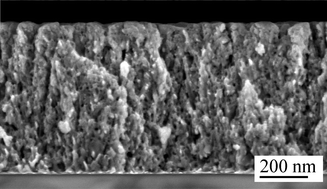Nickel oxide—gadolinia-doped ceria thin films with a ceria composition of 80 at% Ce and 20 at% Gd were grown by pulsed laser deposition on sapphire and SiO2/Si wafers as well as on yttria stabilized zirconia polycrystalline substrates. Upon reduction of the NiO phase in a H2/N2 atmosphere at 600 °C, a stable three-phase, 3-D interconnecting microstructure was obtained of metallic Ni, ceramic, and pores. Coarsening and segregation of the Ni to the surface of the film was observed at higher temperatures. The kinetics of this process depend strongly on the microstructures that can be developed in situ during deposition or post-deposition heat treatments. In situ minimization of Ni-coarsening can be achieved at temperatures as low as 500 °C when the deposition pressure does not exceed 0.02 mbar. For films deposited at higher pressure and at temperatures below 800 °C, coarsening can be minimized post deposition by annealing in air at 1000 °C. The films showed very good metallic conductivity and stability upon thermal cycling in a reducing atmosphere. Redox cycles performed at 600 °C between air and H2 induced a loss of connectivity of the metallic phase and consequent degradation of the conductivity. After 16 cycles, corresponding to 65 hrs, the conductivity is reduced by one order of magnitude.

You have access to this article
 Please wait while we load your content...
Something went wrong. Try again?
Please wait while we load your content...
Something went wrong. Try again?


 Please wait while we load your content...
Please wait while we load your content...